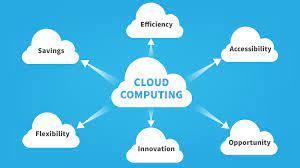Inquire
Unveiling the Cloud: Exploring the Wonders of Cloud Computing

Introduction:
Cloud computing has revolutionized the world of technology and business, offering scalable, cost-effective, and flexible solutions to organizations and individuals alike. In this blog, we will delve into the fascinating world of cloud computing, understanding its core concepts, benefits, challenges, and the profound impact it has on our digital world.
What is Cloud Computing?
Cloud computing is a technology that delivers computing services, including servers, storage, databases, networking, software, and more, over the internet. It eliminates the need for organizations and individuals to own and maintain physical hardware or software, offering on-demand access to a shared pool of computing resources.
Key Concepts in Cloud Computing:
1. Service Models:
- Infrastructure as a Service (IaaS): Provides virtualized computing resources over the internet, such as virtual machines and storage.
- Platform as a Service (PaaS): Offers a platform that includes infrastructure, development tools, and runtime environments for building, testing, and deploying applications.
- Software as a Service (SaaS): Delivers software applications over the internet, accessible via web browsers without any installation.
2. Deployment Models:
- Public Cloud: Services are hosted and maintained by a third-party provider and are available to anyone over the internet.
- Private Cloud: Cloud infrastructure is exclusively used by a single organization, ensuring control and security.
- Hybrid Cloud: Combines both public and private clouds, allowing data and applications to be shared between them.
Benefits of Cloud Computing:
1. Cost Efficiency: Cloud computing eliminates the need for organizations to invest in and maintain expensive hardware and software, instead opting for a pay-as-you-go model.
2. Scalability: Cloud resources can be easily scaled up or down to accommodate fluctuating workloads, ensuring optimal resource utilization.
3. Flexibility: Cloud services offer a wide range of solutions for various use cases, from web hosting to data analytics and machine learning.
4. Accessibility: Users can access cloud services from anywhere with an internet connection, promoting remote work and collaboration.
5. Reliability: Cloud service providers offer high availability and redundancy to ensure uninterrupted service.
Challenges and Considerations:
1. Security: While cloud providers invest heavily in security, organizations must still ensure the security of their data and applications.
2. Data Privacy and Compliance: Regulations like GDPR and HIPAA require organizations to handle data responsibly, which can be challenging in the cloud.
3. Data Transfer Costs: Transmitting large volumes of data in and out of the cloud can be costly.
4. Downtime: Cloud services are not immune to outages, which can impact business operations.

Impact of Cloud Computing:
Cloud computing has transformed the tech industry and businesses in numerous ways:
1. Digital Transformation: Cloud enables businesses to adapt to rapidly changing market demands and adopt new technologies more quickly.
2. Cost Savings: Organizations can reduce capital expenses, lower IT operational costs, and optimize resource usage.
3. Innovation: Cloud computing supports the development of new technologies like artificial intelligence, the Internet of Things (IoT), and big data analytics.
4. Global Reach: Cloud services are accessible worldwide, helping organizations expand their global presence.
Cloud computing is a technological marvel that has not only redefined the way businesses operate but has also empowered individuals with unprecedented access to computing resources. As we continue to witness the evolution of cloud technology and its integration into various aspects of our lives, the impact and potential of cloud computing remain boundless. The cloud, with its scalability, accessibility, and cost-efficiency, promises to be a key driver of innovation and digital transformation in the years to come.

- Managerial Effectiveness!
- Future and Predictions
- Motivatinal / Inspiring
- Other
- Entrepreneurship
- Mentoring & Guidance
- Marketing
- Networking
- HR & Recruiting
- Literature
- Shopping
- Career Management & Advancement


 SkillClick
SkillClick